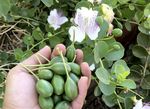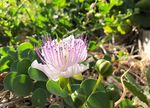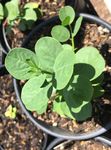Growing Capparis Spinosa Plants - in Maricopa County, AZ 2018
←
→
Page content transcription
If your browser does not render page correctly, please read the page content below
Growing Capparis Spinosa Plants
in Maricopa County, AZ – 2018
About the Caper Plant
The Capparis spinosa plant produces stunning blooms lasting less than a day, but the real attraction for
most growers are the delicious buds (capers) and berries that are harvested then cured by brining or
pickling. Caper plants love hot, dry heat and can survive in the poorest of soil and drought conditions.
In its natural habitat in the Mediterranean, caper plants can be found growing from cracks in walls.
A well-tended Caper is ideally suited for growing in the long, hot, dry summers of the low desert of
Maricopa County, AZ.
Your new Capparis spinosa plant from Vilardi Gardens started life nearly nine months ago as fresh seed
collected from locally-grown plants. Capers are notoriously hard to germinate from dry, dormant seed,
so fresh seed is essential and locally-grown an added bonus because of attributes that parent stock
acclimated to local conditions share with their offspring seed. These reasons alone make your new
Caper plant special, but combined with the fact that they are rarely available, and then only once a
year for a short period of time, means proper care is essential to ensure growing success.
Here in Maricopa County, fresh Caper seed is collected from very ripe Caperberries, each containing
up to 200 tiny seed. The seed is planted in propagation trays and can take up to 22 weeks to emerge.
They grow very slowly at first, and then explode with growth as the weather warms up into spring.
Capers will grow into their space, and these plants have already moved twice, from 1” propagation
cubes they shared with a roommate, to 3½” containers (or their own one-bedroom as I like to call it),
to the existing 5½” pot they reside in now. Your new caper plant will need a much larger, permanent
spot for it to remain thriving. It will be happiest in the ground, with at least six feet in every direction
to sprawl, but they can also be successfully grown in ceramic containers at least 25 gallons, although
larger is always better.
1Growing Capparis Spinosa Plants in Maricopa County, AZ – 2018
Capers need at least six hours a day of full summer sun and can take all day sun if properly cared for.
While mature plants are drought tolerant, these young starts should be watered regularly as they
become established in their new location. To avoid transplant shock, monitor your plant for signs
of stress. If transplanting into the ground, you may want to offer the plant some extra, temporary
shade for the first week or two after transplanting, as well as frequent watering. If transplanting to a
container, slowly expose it to more and more direct sun over a week long period, and water frequently,
as containers can dry out fast.
Caper plants like lots of drainage, so amend your container soil mix with Perlite, par-boiled rice hull,
cactus mix or pumice. In-ground planting can also benefit with these amendments to aid in drainage
and many gardeners will create a mound of high-drainage soil to plant in.
Once your plant begins to grow well, you can begin to reduce the frequency of watering but increase
the amount of water. You are striving for deep roots to give you a long-lived plant. If you are using a
large pot, you will be deep watering every 3-4 days in the winter and every 2-3 days in the summer. If
planting in the ground, depending on the other plants around it, water approximately every 4-6 days
in the winter and every 2-4 days in the summer. Use a water meter (available at most nurseries) as an
instant read on the soil moisture level. Don’t use surface moisture as a guide; check 4-8 inches down
to determine whether it is time to water, or how to set your schedule on automated watering.
Caper plants can live 25+ years and mature plants (4 years +) can produce 10 lbs of caper buds or
20 lbs of caperberries per year, growing three feet high and 12 feet wide.
Your caper is cold-hardy to 18 degrees. It will usually but not always go dormant in the winter here.
Either way, do not prune your plant the first year. Prune back in January each year after that.
Flea beetles may be a problem for young plants. At the first sign of damage (shot-gun like holes in
the leaves) use DE (food-grade diatomaceous earth) in the evening, dusting both the top and bottom
of leaves. Repeat weekly as you see any more damage. Repeat more frequently if it rains or the plant
gets wet from watering.
2Growing Capparis Spinosa Plants in Maricopa County, AZ – 2018
Here are some interesting and important facts about Caper growing:
1. Dried caper seed enters into hyper-dormancy and is very hard to propagate. Cuttings can be
propagated with some success. Fresh caper seed can take up to 22 weeks to germinate and then
only if handled properly. Even with fresh seed, it can take nine months before a Caper plant is
more than two inches high and ready to transplant.
2. Capers can grow up to 12 feet wide and three feet high, and a mature caper plant can produce
about 10 lbs of buds or about 20 lbs of berries a year.
3. Capers naturally thrive and are commercially produced in mostly Mediterranean locales but grow
from Morocco to Australia, with Italy, some Asian locales, Spain and Greece (especially the island of
Crete) also in the mix.
4. Caper gathering is labor intensive, costly and therefore commercial farming is found frequently in
the poorest of Mediterranean countries.
5. Production and plant collection methods, harvesting techniques and processing vary wildly between
regions and countries. For instance:
a. In the Sicilian island of Pantelleria, considered the premier producer of fine capers,
caper plants are cultivated in farms and pruned regularly while in other regions they
are harvested from the wild and never pruned.
b. While some cultures prize the smallest of caper bud, others revere the larger as more
flavorful.
6. Caper leaves are cured as well as buds and berries.
7. There are several ways to cure capers buds and berries. You can use good, coarse salt alone; you
can make a brine of salt and water, or salt, water and vinegar, or salt and just vinegar but salt is
always part of the cure equation, whether the cure is dry or wet.
8. There are over 300 varieties of Caper species.
9. Fledgling commercial caper production has popped up in Australia over the last 10-12 years and
shows promise.
3You can also read























































